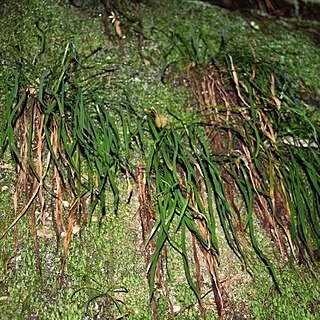Rhizome short-to moderately long-creeping, branched, densely scaly, thickly covered with dark roots with spreading ginger hairs; scales 4–7 (–10) mm long, very slender, uniformly reddish brown when young, ageing black; cell walls uniformly thick; apex hair-like with irregularly toothed margins. Fronds scattered. Lamina linear, 25–90 cm long, 3–5 (–10) mm wide, tapered to both ends, dark green, glossy, thinly coriaceous; midvein prominent in broad-leaved forms; lateral veins very oblique. Paraphyses branched; terminal cells clavate, about as long as wide. [See also Du Puy (1993: 543), Green (1994: 567).]

